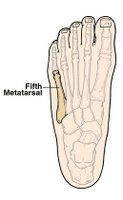
Today is the fifth anniversary of the worst terrorist attack on United States soil, a time to remember those who perished in New York, Washington, and Pennsylvania. Although September 11th of each year was designated "
Patriot Day" by President Bush in December 2001, the name has never really caught on, and most people still refer to it simply as "9/11".
For many reasons, there's an air of uneasiness today. Our world changed on this day in 2001, and hasn't been the same since. Of course, there's the somber memory of the events themselves, as we recall the emotions we felt as they played out before our eyes on the TV news: fearfulness, and incredulity that such a thing could be happening in our own country. As a nation, we have become obsessed with the threat of another, even deadlier terrorist attack, one that might make September 11th look small by comparison. Worst of all, 9/11 has become a propaganda tool, used by a flag-waving administration to justify a preemptive war abroad and a direct attack on civil liberties at home. Regardless of how one feels about the issues, the politicization of 9/11 sullies and degrades the sacred memory of the nearly 3,000 people who died that day.
Like any other major event in our country's history, September 11th has its share of
conspiracy theorists; indeed, a recent Zogby survey revealed that a full
42 percent of the American public think the government must be covering up something about 9/11. A smaller yet still sizeable number of people honestly believe that the U.S. in fact orchestrated the entire affair to justify the invasion of Iraq, hand-picking and training the pilots in Saudi Arabia. Others go further and claim the towers were felled in a controlled demolition by secret government agents who planted explosives in the building prior to 9/11.
As if this isn't hard enough to swallow, there are even wilder theories. Some claim that by closely inspecting video footage of the planes colliding with the World Trade Center towers, a missile can be seen being fired from one of the jets just prior to impact. Others spot what they claim to be a U.F.O. in the video, which they conclude was somehow remotely controlling the planes. A few even go so far as to suggest that rogue elements within the U.S. government, using stealth so-called "Global Hawk" technology, were able to remotely control the aircraft and deliberately fly them into the towers, without any hijackers being involved at all.
While proponents of the above notions may be easy to dismiss as crackpots, there is one other controversial question that appears to still have a considerable amount of traction among theorists: what
really happened to United Flight 93? Did the passengers storm the cockpit in an attempt to retake control from the hijackers, causing the plane to crash? Or was it actually
shot down by U.S. fighter jets, as
some claim? A number of web sites, including this
well-researched page, have explored different theories of the crash and are quite thought-provoking.
They start with the assumption that the crash had to have been caused by one of four things:
- A passenger revolt, which caused the hijackers to either lose control or to deliberately put the plane into the ground short of its target;
- An on-board explosion, which could have occurred if the hijackers were in possession of a real bomb, not one which -- it has been assumed -- was fake and intended only to scare the passengers into docile compliance;
- A mid-air breakup of the plane caused by excessive speed and/or maneuvers by the inexperienced hijacker pilot that stressed the airframe beyond its flight performance envelope, or;
- The plane was shot down by Air National Guard F-16 interceptors on orders from the Pentagon.
The uplifting "common man rises up and fights back in the face of insurmountable odds" theme has resonated in popular American legend ever since the Minuteman and the Boston Tea Party, and the passengers-as-heroes theory has been warmly accepted by the public as one of the few good things that occurred on that horrible day. It has been made into a cable-TV movie (A&E's "
Flight 93"), a theatrical release ("
United 93", by acclaimed director Paul Greengrass), and the National Park Service will spend approximately $58 million dollars to build a "Flight 93 National Memorial" in the field just outside of Shanksville, PA where the plane crashed. According to the Project's
website,
"The story of Flight 93 is a national treasure — a story of hope in human courage and cooperation. When confronted with the gravity of their situation, the passengers and crew of Flight 93 chose to act heroically and sacrifice their lives for their country. These 40 heroes made a democratic decision to fight back against terrorism and thereby thwarted a planned attack on our nation’s capital, saving countless numbers of lives."
No one really wants to argue with that ... but did they? There are some who aren't so sure, and cite a number of factors which raise disturbing questions:
• There were at least two or more separate debris fields following the crash. In addition to the one main crater where the plane hit the ground nearly vertically at a speed estimated at 500 mph, there was a second site some two miles away where one of the plane's engines, weighing over 1,000 pounds, was found nearly intact. Other debris was found up to 8 miles from the crash site. How can this be explained?
• After the attacks on the World Trade Center and the Pentagon, President Bush gave the military orders to intercept and shoot down any commercial airliners that refused instructions to turn away from Washington, according to Vice President Dick Cheney in a statement on NBC's
"Meet The Press". "I wholeheartedly concurred in the decision he made, that if the plane would not divert, if they wouldn't pay any attention to instructions to move away from the city, as a last resort our pilots were authorized to take them out," Cheney said. This order was given at approximately 9:35 AM, more than a half-hour before Flight 93 crashed at 10:10 AM. There are those who find it hard to believe that an F-16, capable of traveling at up to three times the speed of the Boeing 757, would not have been able to intercept it and take action.
• One caller aboard Flight 93 reported that they were locked in a rest room and reported he heard the sound of an explosion, and saw white smoke entering through the door, at least 30 seconds before the crash.
• Numerous eyewitnesses on the ground reported seeing a small, white, unmarked jet aircraft swoop low to tree-top level immediately after the crash, then fly away. Others heard two separate explosions; one in mid-air, and the second when the plane hit the ground.
Regardless of what actually caused the plane to crash, no one doubts that the passengers did, in fact, realize their fate and had organized themselves in an attempt to do something about it. From the mid-air phone calls made following the hijacking, there is no question that there was some attempt to storm the cockpit and take back the plane. Beyond that, no one can say anything for sure. Although the families of the victims are 100% certain that their loved ones were successful at subduing the hijackers, at no time has the FBI, FAA, NTSB, or any other government agency provided any statement or evidence that the passengers were able to penetrate the cockpit. Theoretically, the plane's Flight Data Recorder (which monitors technical information about the flight, such as altitude, speed, engine performance, control surfaces, etc.) should provide information from which this could be determined, but investigators refuse to release any public information about it. (Note: the Flight Data Recorder should not be confused with the Cockpit Voice Recorder, which contains only sound and
has been made public.)
The ultimate irony, which no one wants to think of: what if the passengers were successful in regaining control of the plane, and had dispatched the hijackers ... then, moments before they could change course, were struck by an air-to-air missile? Do you honestly think the government would admit to such a tragic mistake?
However, such speculation is pointless today, perhaps even inappropriate. This should be a day of meditation and remembrance. It might even be a good day to go see Oliver Stone's latest movie, "
World Trade Center", which features riveting performances by Nicolas Cage and others, including actual rescuers and first responders who were present at Ground Zero. According to
Newsweek, "'World Trade Center' celebrates the ties that bind us, the bonds that keep us going, the goodness that stands as a rebuke to the horror of that day." It's a gritty, powerful film which "touches on a profound national faith in the courage and steadfastness of common men and women".
We could all use a little of that, and not just today.
 As if there isn't already enough excitement in my life, I now have a broken foot. Technically it's called a "fifth metatarsal fracture" (see diagram, right) and is, I'm told, a fairly common injury. Now we all know that few things in life are more hilarious than a broken bone, so here's a fun idea: let's play a little multiple-choice game where you try to guess exactly how I managed to do this:
As if there isn't already enough excitement in my life, I now have a broken foot. Technically it's called a "fifth metatarsal fracture" (see diagram, right) and is, I'm told, a fairly common injury. Now we all know that few things in life are more hilarious than a broken bone, so here's a fun idea: let's play a little multiple-choice game where you try to guess exactly how I managed to do this:





















 Blogs I've been reading lately
Blogs I've been reading lately




